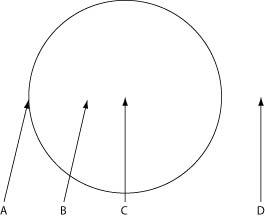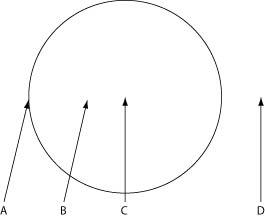An important example of interaction between fungi and certain other organisms is mycorrhizae, in which the fungal partners _____.
A) cause the decay of cellulose and lignin
B) provide carbohydrates to the plant partner
C) control soil nematodes
D) help plants take up nutrients and water
E) sicken herbivores that attempt to feed on plants
D
Which term describes the fusion of cytoplasm from two individuals?
A) Spore
B) Heterokaryotic
C) Plasmogamy
D) Karyogamy
C
Which structure is not directly involved in the reproduction of at least one major group of fungi?
A) Mycelium
B) Motile spores
C) Basidium
D) Asci
A
True or false?
In most fungi, fertilization is complete after the cells fuse together.
False
Where does meiosis occur in a mushroom?A) Basidia
B) Hyphae
C) Mycelium
D) Spores
A
Which structure allows the growing mushroom to nourish itself?
A) Basidia
B) Spore
C) Mycelium
D) Gills
C
Which of the following events occurs first in the development of a spore into a mature mushroom?
A) A heterokaryotic mycelium forms.
B) Hyphae are produced by mitosis.
C) The mycelium forms.
D) Haploid nuclei fuse to form a diploid nucleus.
B
True or false?
Most of the cells in a mushroom contain haploid nuclei.
True
Fungi of the phylum Ascomycota are recognized on the basis of their production of _____ during sexual reproduction.
A) saclike structures
B) flagellated zoospores
C) yeasts
D) a dikaryotic structure
E) lichens
A
Which of the following characteristics is unique to chytrids compared to other groups of fungi?
A) cell walls of cellulose
B) autotrophic mode of nutrition
C) nucleotide sequences of several genes
D) presence of flagella
E) heterotrophic mode of nutrition
D
What are the sporangia of the bread mold Rhizopus?
A) sexual structures that produce diploid spores
B) asexual structures that produce diploid spores
C) sexual structures that produce haploid spores
D) asexual structures that produce haploid spores
D
You are given an organism to identify. It has a fruiting body that contains many structures with eight haploid spores lined up in a row. What kind of a fungus is this?
A) basidiomycete
B) ascomycete
C) chytrid
D) deuteromycete
E) zygomycete
B
Arrange the following from largest to smallest:
1.
ascospore
2. ascocarp
3. ascomycete
4. ascus
A) 3 → 4 → 2 → 1
B) 3 → 2 → 4 → 1
C) 3 → 4 → 1 → 2
D) 2 → 4 → 1 → 3
E) 2 → 3 → 4 → 1
B
Among sac fungi, which of these correctly distinguishes ascospores from conidia?
A) Ascospores have undergone genetic recombination during their production, whereas conidia have not.
B) Ascospores are larger, whereas conidia are smaller.
C) Ascospores are diploid, whereas conidia are haploid.
D) Ascospores are produced only by meiosis, whereas conidia are produced only by mitosis.
E) Ascospores will germinate into haploid hyphae, whereas conidia will germinate into diploid hyphae.
A
In what structures do both Penicillium and Aspergillus produce asexual spores?
A) conidiophores
B) gametangia
C) zygosporangia
D) rhizoid
E) sasci
A
For several decades now, amphibian species worldwide have been in
decline. A significant proportion of the decline seems to be due to
the spread of the chytrid fungus, Batrachochytrium
dendrobatidis (Bd). Chytrid sporangia reside within the epidermal
cells of infected animals, animals that consequently show areas of
sloughed skin. They can also be lethargic, which is expressed through
failure to hide and failure to flee. The infection cycle typically
takes four to five days, at the end of which zoospores are released
from sporangia into the environment. In some amphibian species,
mortality rates approach 100%; other species seem able to survive the infection.
Apart from direct amphibian-to-amphibian contact, what is the
most likely means by which the zoospores spread from one free-living
amphibian to another?
A) by flagella
B) by cilia
C) by wind-blown spores
D) by pseudopods
E) by hyphae
A
Chemicals, secreted by soil fungi, that inhibit the growth of bacteria are known as
A) aflatoxins.
B) antibiotics.
C) antibodies.
D) hallucinogens.
E) antigens.
B
Lichens are symbiotic associations of fungi and
A. mosses.
B. cyanobacteria.
C. green algae.
A and B
B and C.
B and C
In both lichens and mycorrhizae, what does the fungal partner provide to its photosynthetic partner?
A) protection from harmful UV
B) antibiotics
C) carbohydrates
D) fixed nitrogen
E) water and minerals
E
Which of the following best describes the physical relationship of the partners involved in lichens?
A) Algal cells and fungal cells mix together without any apparent structure.
B) Photosynthetic cells are surrounded by fungal hyphae.
C) The fungi grow on rocks and trees and are covered by algae.
D) Fungal cells are enclosed within algal cells.
E) Lichen cells are enclosed within fungal cells.
B
When pathogenic fungi are found growing on the roots of grape vines, grape farmers sometimes respond by covering the ground around their vines with plastic sheeting and pumping a gaseous fungicide into the soil. The most important concern of grape farmers who engage in this practice should be that the
A) lichens growing on the vines' branches are not harmed.
B) fungicide might also kill mycorrhizae.
C) fungicide might also kill the native yeasts residing on the surfaces of the grapes.
D) sheeting is transparent so that photosynthesis can continue.
B
Sexual reproduction has never been observed among the fungi that
produce the blue-green marbling of blue cheeses. What is true of these
fungi and others that do not have a sexual stage?
1) They are
currently classified among the ascomycetes.
2) They do not form
heterokaryons.
3) Their spores are probably produced by mitosis.
4) They form dikaryotic mycelium.
5) The spores undergo
crossing over during meiosis.
A) 2, 4, 5
B) 1, 4, 5
C) 1, 2, 4
D) 2, 3
E) All of the choices are correct.
D
A billionaire buys a sterile volcanic island that recently emerged from the sea. To speed the arrival of conditions necessary for plant growth, the billionaire might be advised to aerially sow what over the island?
A) soredia
B) yeasts
C) basidiospores
D) leaves (as food for fungus-farming ants)
E) spores of ectomycorrhizae
A
Which of the following cells or structures are associated with asexual reproduction in fungi?
A) basidiospores
B) ascospores
C) Zygosporangia
D) conidiophores
E) ascocarps
D
The photosynthetic symbiont of a lichen is often
A) a small vascular plant.
B) a moss.
C) an ascomycete.
D) a green alga.
E) a brown alga.
D
Among the organisms listed here, which are thought to be the closest relatives of fungi?
A) animals
B) slime molds
C) vascular plants
D) mosses
E) brown algae
A
The adaptive advantage associated with the filamentous nature of fungal mycelia is primarily related to
A) an extensive surface area well suited for invasive growth and absorptive nutrition.
B) avoiding sexual reproduction until the environment changes.
C) the ability to form haustoria and parasitize other organisms.
D) the potential to inhabit almost all terrestrial habitats.
E) the increased probability of contact between different mating types.
A
Most fungi are _____.
A) photoautotrophs
B) decomposers
C) herbivores
D) carnivores
E) chemoautotrophs
B
Fungi release digestive enzymes into their _____.
A) surroundings
B) gastrovascular cavity
C) stomach
D) hyphae
E) mycelia
A
Basidia produce spores by a process known as _____.
A) decomposition
B) mitosis
C) meiosis
D) hyphae
E) binary fission
C
Fungi obtain nutrients through _____.
A) ingestion
B) chemosynthesis
C) absorption
D) endocytosis
E) photosynthesis
C
The body of most fungi consists of threadlike _____, which form a network called a _____.
A) hyphae ... mycelium
B) mycelia ... dikaryon
C) hyphae ... chytrid
D) mycelia ... hypha
E) sporangia ... dikaryon
A
Some fungal species can kill herbivores while feeding off of sugars from its plant host. What type of relationship does this fungus have with its host?
A) predatory
B) mutualistic
C) commensal
D) parasitic
B
What sexual processes in fungi generate genetic variation?
A) karyogamy and meiosis
B) plasmogamy and meiosis
C) budding and meiosis
D) haustoria and karyogamy
E) diploidy and the heterokaryotic condition
A
At which stage of a basidiomycete's life cycle would reproduction be halted if an enzyme that prevented the fusion of hyphae was introduced?
A) fertilization
B) karyogamy
C) germination
D) plasmogamy
D
Which feature seen in chytrids supports the hypothesis that they diverged earliest in fungal evolution?
A) parasitic lifestyle
B) the absence of chitin within the cell wall
C) flagellated spores
D) coenocytic hyphae
C

The following figure depicts the outline of a large fairy ring that
has appeared overnight in an open meadow, as viewed from above. The
fairy ring represents the furthest advance of this mycelium through
the soil. Locations A-D are all 0.5 meters below the soil surface.
What is the most probable location of the oldest portion of this mycelium?
A
B
C
D
C

The following figure depicts the outline of a large fairy ring that
has appeared overnight in an open meadow, as viewed from above. The
fairy ring represents the furthest advance of this mycelium through
the soil. Locations A-D are all 0.5 meters below the soil surface.
Which location is nearest to basidiocarps?
A
B
C
D
A
Which of the following best describes the physical relationship of the partners involved in lichens?
A) Fungal cells are enclosed within algal cells.
B) Photosynthetic cells are surrounded by fungal hyphae.
C) The fungi grow on rocks and trees and are covered by algae.
D) Lichen cells are enclosed within fungal cells.
B